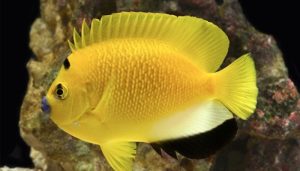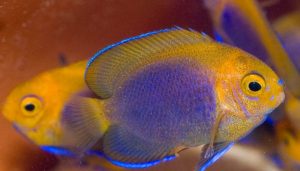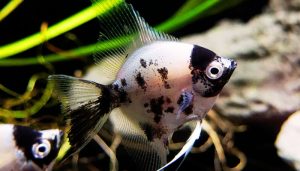If you’re a proud aquarium owner looking to keep your tank clean and vibrant, you’ve likely considered adding algae-eating companions to your aquatic family. But when it comes to unique and hardworking cleanup crews, one question often arises: Do Rabbit Snails Eat Algae?
Yes, rabbit snails are excellent algae eaters. They diligently consume algae growing on tank surfaces, plants, and decorations, making them a fantastic choice for keeping your aquarium spotless.
Alongside algae, they also feed on leftover fish food and plant debris, contributing to a well-balanced and clean environment.
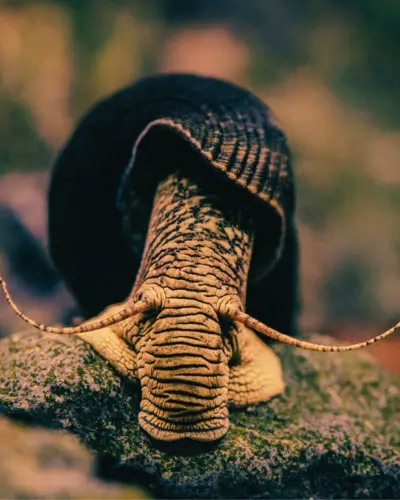
These fascinating creatures are not only eye-catching with their spiral shells and gentle movements but are also known for their ability to maintain a clean and healthy aquarium.
In this post, we’ll dive into the habits of rabbit snails, explore their dietary preferences, and uncover whether they’re the perfect fit for your tank’s ecosystem.
So, if you’re curious about these fascinating creatures and want to learn more about what they eat, be prepared for some unexpected discoveries!
Table of Contents
ToggleDo Rabbit Snails Eat Algae?
Will rabbit snails eat algae in tanks? Yes, rabbit snails are voracious eaters; algae is one of their favorite foods. They will consume most soft algae that grow on hard surfaces in your freshwater tank.
They are also excellent scavengers, feeding on detritus (decaying organic matter) and leftover food in the substrate. However, it’s important to note that their diet shouldn’t be limited to what they naturally find in the tank.
To keep them healthy, you should also supplement their diet with:
- Sinking pellets
- Algae wafers
- Fish flakes
- Blanched green vegetables like zucchini, lettuce, and spinach
Are Rabbit Snails Good Algae Eaters?
When it comes to algae control in an aquarium, golden rabbit snails can be helpful to some extent. They are not as efficient as some other snail species like mystery snails, nerite snails, and ramshorn snails but they help keep the tank clean by consuming algae and waste.
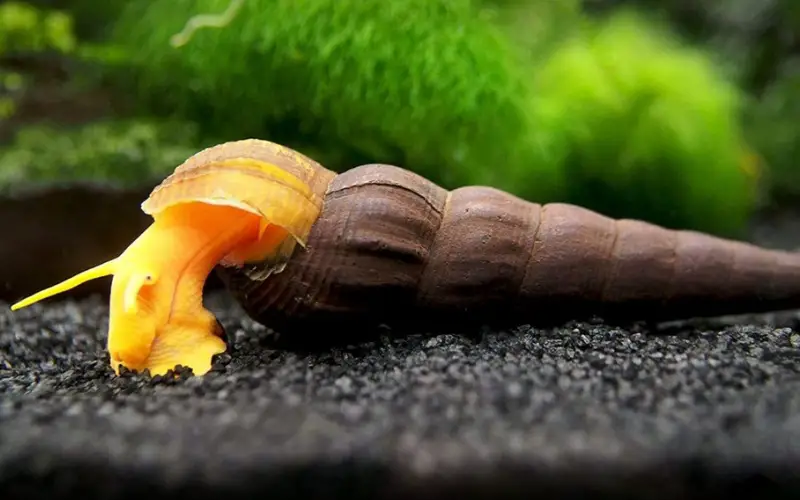
However, they are not typically considered the best algae eaters due to their relatively slower feeding habits. Additionally, rabbit snails are more focused on eating dead or dying plant matter, so they may not be the best choice if algae control is your primary concern.
Rabbit snails are peaceful creatures that can be kept with various tankmates, including freshwater shrimp, guppies, Corydoras, and other peaceful tank mates.
They are hardy and can thrive in various conditions but prefer warmer water temperatures. Rabbit snails are also known to injure live aquarium plants, so they are best kept in a tank with leafy plants like java fern or Anubias that they are less likely to consume.
Do Rabbit Snails Eat Hair Algae?
Rabbit snails are not the best choice for targeting hair algae in your tank. While they are algae eaters, they tend to focus on biofilm and other algae types like detritus.
Here are some better options for controlling hair algae:
- Turbo snails: These are known algae erradicators and will happily munch on hair algae.
- Bumblebee snails: Another good option for hair algae control.
- Astrea snails: These are also effective algae eaters.
If you’re set on getting a rabbit snail from your nearby pet store, it can still be a helpful addition to your tank by cleaning up biofilm and other organic matter. Keep in mind you might need other creatures to target the hair algae specifically.
Rabbit Snail Caring Tips & Tank Requirements
Rabbit snails, also known as elephant snails or poso snail, are a unique addition to any aquatic tank. These snails are known for their distinctive shell growth and come in various colors such as orange, yellow, golden, rabbit snails chocolate, and white spotted rabbit snails.
When caring for rabbit snails, providing them with a tank size of at least 10 gallons and stable nitrate levels is essential. Rabbit snails also require a calcium-rich diet to maintain their shell health.
Adding assassin snails to the tank can help control the population of snails and prevent them from overrunning the tank. Additionally, Orange rabbit snails can be kept in a community tank with Corydoras, loach, and goldfish.
Regarding tank requirements, it is essential to have a filter system in place to keep the water clean and fertilizer levels balanced. Rabbit snails prefer a planted tank with plenty of hiding spots and places to explore. They also require a canister or sponge filter intake to ensure optimal water parameters.
Keeping an eye on the ammonia and nitrite levels in the tank is crucial, with the ideal nitrite levels at 0 ppm. Rabbit snails are known for their snail breeding habits, so they must be prepared to lay eggs. The eggs are typically enclosed in a small, white egg sack that can be spotted on the tank walls or decorations.
What Kind of Snail Eats Algae?
Nerite snails are widely recognized as excellent algae eaters in freshwater aquariums. These small, colorful snails are particularly effective at tackling green spot algae, a stubborn type of algae that can be difficult to remove.
Other snails that also contribute to algae control include:
- Mystery snails: While not as specialized as nerite snails, mystery snails are opportunistic feeders and will consume algae along with other food sources.
- Rabbit snails: These snails are known for their appetite for soft algae and detritus, making them helpful in maintaining a clean aquarium environment.
Important Note: While these snails are effective at controlling algae, it’s crucial to provide a balanced diet to ensure their overall health. Supplementing their diet with algae wafers or other appropriate food sources is recommended, especially if algae growth is minimal.
Commonly Asked Questions about Rabbit Snails vs. Algae Nightmare (FAQs)
Will snails eat algae wafers?
Yes, many snail species enjoy algae wafers! They’re a good supplement if your tank lacks algae. But snails have small mouths, so they break wafers into smaller pieces.
Are rabbit snails bad?
Rabbit snails are suitable for a well-established aquarium. They’re peaceful scavengers that clean up waste and algae. However, they may occasionally munch on live plants if they’re hungry.
Will rabbit snails eat other snails?
No, rabbit snails are herbivores and detritivores. They munch on algae, decaying plants, and leftover fish food. While they might nibble on slow-moving snails, they won’t actively hunt them.
Will rabbit snails eat Java fern?
Rabbit snails are algae eaters, but some may nibble on Java fern. To prevent this, offer them sinking pellets or blanched veggies like zucchini. If you see damage, supplement their diet or consider other peaceful algae eaters.
What is the behavior of a rabbit snail?
Rabbit snails are peaceful scavengers. They spend their days sifting through the tank for algae, biofilm, and leftover food. They’re curious explorers and can be active day or night. Just be sure your tank lid is secure, as they’re known escape artists!
What plants do rabbit snails not eat?
Rabbit snails are primarily algae eaters but may nibble on plants. They’re generally safe for most aquarium plants except Java Ferns. Offer blanched veggies like zucchini to keep them from munching on your greenery.
How can you tell the difference between Malaysian trumpet snails and rabbit snails?
Size is the key! Rabbit snails are much larger than Malaysian Trumpets, reaching over 2 inches in length. Look for “rabbit ear” antennae on black rabbit snails, while Malaysian Trumpets have regular stalks.
Are rabbit snails hard to breed?
Rabbit snail breeding is easy. They need good water and a male present. They reproduce slowly, laying eggs every 4-6 weeks.
Do rabbit snails clean a tank?
Yes, rabbit snails are effective tank cleaners. They consume algae, leftover food, and decaying matter, helping to maintain water quality and a healthy aquarium environment.
Conclusion
So, while rabbit snails might not be the hair algae assassins you hoped for, they’re valuable members of a well-balanced tank ecosystem. Consider turbo snails or their bumblebee and Astrea cousins for dedicated hair algae removal. Remember, a diversified cleaning crew is vital to a sparkling clean aquarium! But before you introduce any new friends, be sure to research their compatibility with your existing tank inhabitants. Happy fish keeping! (Did you learn everything you wanted to know about do rabbit snails eat algae? Let us know in the comments below!)
Recommended Posts
- Do Rabbit Snails Reproduce Asexually: (The Shocking Truth)
- Rabbit Snail Colors 101: AMAZING Shades You Won’t Believe!
- Rabbit Snail Tank Size 101: Setting Up the Perfect Aquarium
- Rabbit Snail Breeding 101: A Comprehensive Beginner’s Guide
- What Do Rabbit Snails Eat: (5 Foods They Can’t Resist!)
- Rabbit Snail Not Moving in Aquarium: (Troubleshooting Tips)
- Will Rabbit Snails Eat Plants in Aquarium: (Experts Advice)
- Rabbit Snail Egg 101: The Art of Snail Breeding in Tanks


